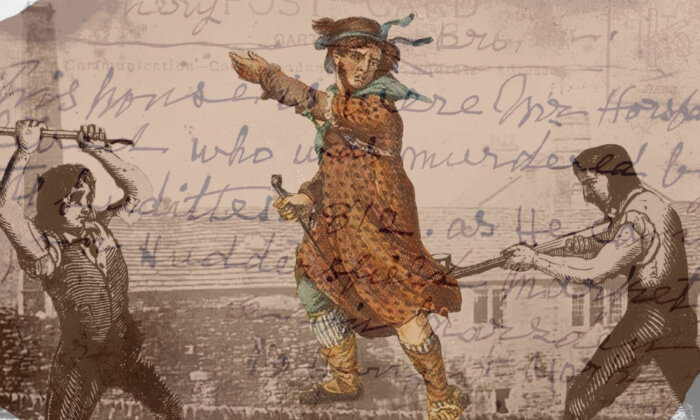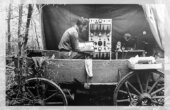The Future Encyclopedia of Luddism

In common parlance, the term “Luddite” means someone who is anti-technology, or maybe, just not adept at using technology. Historically, however, the Luddite movement was a reaction born of industrial accidents and dangerous machines, poor working conditions, and the fact that there were no unions to represent worker interests during England’s initial period of industrialization. The Luddites did not hate technology; they only channeled their anger toward machine-breaking because it had nowhere else to go.
What you are about to read is an alternate history (an encyclopedia entry from circa 2500) that depends on the critical assumption that the Luddites succeeded in their industrial campaign in the 1810s. Instead of techno-determinism (that the development of technology is inevitable, and that society will alter and adjust to it) the Encyclopedia entry notes that the Luddites, in their success, formulated a different, yet productive, relationship between society and the development of technology.
Originating in Great Britain during the Industrial Revolution in the first two decades of the 19th century, Luddism was a movement arising as a response to poor working conditions in nascent textile manufacturing businesses. The Luddite movement was a precursor to the development of the economic philosophy known as Sustainomics, which promotes technological development that adheres to principles of Utilitarianism and Human Flourishing Doctrines. Sustainomics began its rise in the early part of the 20th century and has remained the dominant economic system of the Hemispheric Union for the past 600 years.

Beginning in the early 19th century, foreign wars coupled with high unemployment and food shortages caused widespread desperation among the populace. Many seeking “earned wages” went to work in rudimentary industrial factories. With no safety standards and shoddy medical care, industrial accidents were quite common.
As corn became increasingly scarce in the winter of 1810 to 1811, groups of workers who could not pay for food and shelter became even more desperate. Under the Combination Act of 1799, Parliament had outlawed unions. It was amidst these stark conditions that the Luddites began to organize in secret. The Luddite Movement was open to both women workers and child laborers. Indeed, women and children comprised roughly 40 percent of the Luddite membership.
Leadership of General Ned Ludd and Origin of the Term ‘Luddite’
Many stories and legends have grown up around the esteemed figure of General Ned Ludd, named by “Passage Zine” as one of the “Top 10 Most Influential People of the Last Thousand Years.” Hailed as a visionary even in his own time, the Luddite Councils are named in his honor. The complete story of Ludd’s life and times is told in “The Epic Saga of General Ludd.” While stylized, the Saga has largely been corroborated with the archaeological records.
As an orphan, young Ned grew up in the late 1790s in a “workhouse,” a facility that existed to make people “earn their keep,” to use the antiquated terminology and backward thinking of the time. Ned was trained in the textile trade as a boy. Contemporary sources recount 15-year-old Ned being beaten when he refused to work at a machine that had, only moments beforehand, severed one of his co-worker’s arms. After several days of docked wages, Ned, still nursing bruises from his beating, was told to go back to work on that same dangerous device. As every schoolchild learns in reading “The Luddite Primer,” young Ned seized a hammer and smashed the hazardous machine. Within a fortnight Ned had fled the factory and joined the British army.

Although he had only a brief stint in the military, young Ned was a quick student of battlefield strategy. Returning to Huddersfield just a few years later, his supporters styled him “General Ludd.” As the Movement increased in popularity over the summer of 1811, a large crowd gathered at Huddersfield. By the time the Movement began in earnest, Ned Ludd’s supporters numbered over 100,000. Luddite supporters were characterized by their sense of utmost loyalty and solidarity to their brothers and sisters in the Movement. Despite the large number of supporters and the completely rudimentary communication available at the time, the Movement, its leaders and its political and social aims remained a well-guarded secret to factory owners and the government alike.
Takeover of Factories
Beginning in November 1811, General Ludd and his right-hand man, Lt George Mellor, surrounded, took and held factories throughout the textile district of Nottinghamshire. Their first victory, at Cartwrights Mill at Rawfolds, is now the site of the Mellor Memorial Museum, which contains many of the original documents so central to the Luddite Movement. Much of the success of the early campaigns was largely due to the fact that the Luddites were chiefly a peaceful movement. Contemporaneous newspaper accounts described individual events as the “occupation” of factories. This characterization has since been disputed by researchers, and definitive archaeological studies have completely repudiated these polemic accounts as wholly fabricated.
Typically, when the Luddites arrived at a factory, the oppressed wage earners cheered and chanted: “Up with Ludd!”
Remarkably, in the first two years of the Luddite campaign, only one serious injury was reported. The owner of Ottiwells Mill, William Horsfall, refused to stand down when a peaceful crowd gathered around his factory. After shouting that he planned to “swim in Luddite blood,” Horsfall began firing his rifle indiscriminately into the largely unarmed crowd, which included many of the factory’s large group of child workers. As a defensive measure, Lt Mellor fired a single shot, intending to hit Horsfall’s arm, but which instead injured his groin. No further resistance was encountered and the factory changed hands without incident.

The Ottiwells Mill incident was an anomaly. Typically, when the Luddites arrived at a factory, the oppressed wage earners cheered and chanted: “Up with Ludd!” Many deserted to join the Luddite forces. Against this overwhelming show of support for the Movement, most of the managers and owners would turn and run or else peacefully surrender. Part of why Ludd could count on such support was that Lt Mellor began by strategically targeting the factories that had the worst records of safety and that paid the lowest wages. After a Luddite victory, local towns would break into impromptu celebrations. Later these celebrations were formalized to become the most important state holiday of the Hemispheric Union. Every year on 1 March, and under the formula of equivalency on Mars, “Ludd Day” commemorates the courageous citizens who took part in the Movement. The day is characterized by rest from labor, time with family and community, fashion shows with costumes from Regency Britain and a dinner of fish and chips. It is also a well-recognized, though not universal, custom to give a hand-made item of clothing to a loved one, in order to commemorate the Movement’s origins in the textile industry.
Luddite Ceremonial Hammers
Sometime in 1812 a group of Ludd’s followers in Nottingham gained control of a tool factory, and used its metal-working machines to construct large hammers. In turn, those involved in factory takeovers would use the massive hammers to break machines that had been responsible for death or injury by industrial accident. Ludd’s own hammer was named “Great Enoch.” The original hammers were later employed in ceremonial capacities establishing trade relations between the United Kingdom with Russia and Japan, before the Great Consolidation into the Hemispheric Union. Today the original ceremonial hammers are displayed in the British Museum’s Robert Owen Branch in Valles Marineris, Mars.
Response to the Luddites
By 1813 the British government faced a severe crisis. Waging the Napoleonic Wars had depleted the Crown’s treasury. Inflation was high, and food shortages persisted. Until that time the Luddites had mostly been seen as a nuisance. The Luddite Movement then emerged from the fringes, however, to capture the support of an economically depressed populace. By the time Parliament grasped that the wage earners were serious about not being abused and would not back down, the Luddites had already gained significant power. By that point the Luddites had control of over half the output of Britain’s textile factories.
At that time the United Kingdom’s factories were critical to mercantilism. This economic system involved the colonies shipping raw materials to Britain, with factories using those inputs to manufacture valuable goods. The end results were then returned and sold back to the colonists. Upon realizing that the entire mercantile system was in jeopardy, certain elements in Parliament who stood to lose their livelihoods pressed for military intervention. Many formerly wealthy factory owners also petitioned for redress. They proposed reforms that would fundamentally change the law towards machine breaking. At that time the laws dealing with property damage uniformly suggested that anyone found guilty would be transported, i.e., sent to Australia or another distant colony looking for settlers. Industrial and mercantile interests, which quickly coalesced into the “Property First Party,” wanted to change the punishment for machine breaking to death by hanging.
Fortunately, for Sustainomics as we know it, the Property First Party failed to pass this legislation. Lord Byron, poet laureate of the Luddite Movement, and eventual MP from Nottinghamshire, whipped up popular sentiment in favor of the Luddites with his volume “Poems in Celebration of Luddism.” These poems were eventually set to music and included the first recorded noises, which were mostly of machines. This began the first era of “Industrial Music,” which is recognized as the official traditional music of the Hemispheric Union.
Tides Turn towards the Luddites, and Their Ultimate Victory
In 1813 the Luddites set their sights on Manchester, which was the heart of industrial cotton processing in England. Although the British army had by then been called out to put down what Parliament was dismissively calling the “Luddite disturbance,” there simply was not the manpower to spare. The army’s reserves were spread thin and taxed heavily defending Britain from the French and Americans.
Richard Arkwright’s factory in Manchester was the first to be liberated. The Luddites swarmed the factory and others near it, to the jubilant reaction of wage earners. Once the major factories in Manchester were under the control of the former wage earners, tradespeople and small artisans, support for the Luddites swelled even further. By 1815 the government had no choice but to declare an amnesty and to grant all the Luddites’ demands.
In late 1815 Parliament passed the Luddite General Amnesty Law. This law overrode all previously imposed legal penalties and sanctions that might have been imposed not only on Luddite leaders but also on supporters. In 1816, as a result of further political pressure arising from a groundswell of popular support, Parliament passed the Democratic Factory Act, followed by the Luddite Peace Accords. The Democratic Factory Act of 1816 outlined what we now recognize as prototypes of today’s Luddite Councils and cadres, and this law was also the official genesis of Sustainomics.
Textile Factories under Early Luddite Rule
Contrary to some of the partisan accounts of the day written by factory “owners,” the Luddites were for the most part very careful with industrial machines. Upon the surrender of a factory, the Luddites would break one or two machines that were especially dangerous and had injured a worker. After breaking the isolated machine to make a calculated statement, the Luddites would carry out a thorough assessment of the facilities. Lt Mellor had a natural facility as an auditor and accountant. He would analyze the books and records of the factory to ascertain its profitability and the suitability of the factory for continuing in its present course, if it paid living wages and did not use child labor.
Upon the surrender of a factory, the Luddites would break one or two machines that were especially dangerous and had injured a worker.
Reflecting Mellor’s business genius, the majority of the factories that were surrendered to the Luddites were up and running under worker-owned management within a matter of days or weeks. The workers in Luddite-run factories were treated as the owners of the shop, as if they had established it from the start. As long as there was no threat to human life, the factory machines were treated respectfully and with reverence. Mellor was committed to repaying the factory owners the true value of the land and machines, and payments were made through 1816. The Luddite Peace Accords of that year established a compensation fund that extinguished any existing claims.
Resulting Peace and the Economic Power of the Cadres
In 1817 Manchester hosted a ceremony in which the Luddites ceremonially stowed away their hammers. With factories under worker control, the Luddites turned their goals towards a political movement that promoted smart growth and democratic technology policies. As part of the peace, factories came to be seen as partially owned by workers, with workers holding seats on every factory’s board of directors. Workers were no longer paid hourly “wages,” an antiquated notion indeed, but instead given dividends on the production that they dedicated themselves to guiding. They were also no longer called “wage earners” or “employees,” terms that implicated servile or subordinate status. Instead, they came to be known collectively as “cadres,” though to this day some of the archaic terminology still exists. The organizational structure the cadres pioneered has long endured, and in fact is the ubiquitous form of corporate holding in the Hemispheric Union.
Establishment of the Luddite Councils
In the early 1820s each factory set up its own distributed “Luddite Council,” which was elected from the cadres. Growing out of a notion that industrial technology was outpacing the human ability to respond to it – or, for that matter, even comprehend it – the Luddite Councils were set up to discuss and debate proposed technological changes. To be certain, some inventions were seen as those that could have either positive or negative results, and for the most part inventors continued to tinker and be incredibly productive. But it was understood that there needed to be a communal discussion of the nature of technological change and advancement as the technologies were being implemented. The cadres were not convinced that the free market should be the only determinant of technology. Instead, they firmly believed that technology had to be adopted democratically and used for the common good, not just the interests of the few. Ludd’s speeches during this time made the point that technological goals and resource allocation were to be decided in advance based on social needs and prioritization, and invention was to be paid for and encouraged in those areas.
The first round of consideration by the Luddite Councils determined that, given the food shortages during the past decade, agricultural technology, food distribution, health and nutrition would be the top priority.
To track and improve food delivery systems, many cadres became involved in the design of analytical engines, pioneered by Charles Babbage and Lady Ada Lovelace, Lord Byron’s daughter. During the 1830s these analytical engines became more sophisticated and had a place in every Luddite factory. Other cadres became adept at designing and fixing harvesting and planting machines that could operate virtually autonomously. Great advances in communications were also needed. The Luddite Councils provided monetary grants for new and improved forms of communication, and by the 1830s telephonic intermediaries were in widespread usage. Rudimentary data storage areas were set up around the world and analytical engines were set to analyzing them. Luddite Councils used these results in order to set budgetary and technological priorities.
Role of Lyanna Ludd and Continued Development of the Luddite Councils
When she reached adulthood, Ludd’s daughter Lyanna headed two of the major Luddite Councils, directing and carrying out their policies for many years. The original purpose of the Luddite Councils was to provide citizens with a forum for discussing and debating technology and the common values that they wanted to embed within those technologies.
Under Lyanna’s, as well as her daughter Sophia’s, guidance, the Luddite Councils had a member of the board on every factory when the cadre numbered more than 25. When new technology was proposed, the Luddite Councils typically supported the changes so long as the labor-saving gains were then distributed as dividends to the cadres.
Further, Lyanna and Sophia both strongly supported the idea that everyone, regardless of gender, race, religion or age, had important contributions to make to the cadre. Unlike other societies at the time, which pushed women into lower-paying work, under Lyanna’s guidance full economic equality for women was achieved. Social equality did not come until the 25th century, but Lyanna’s work provided important groundwork for social change within the cadres.
Advances of the Luddite Councils
Robert Owen, a well-known industrialist from Scotland who was also a utopian visionary, consulted with many worker cadres. In particular, Owen helped the children who had been working in many factories. In many instances these children were orphans or residents of poorhouses. In consultation with the cadres, it was determined that the proper place for these children was school. Owen and the cadres established special schools of engineering and technology so that the children could learn how to construct new and better industrial machines. It was a graduate of one of these Owenite schools, Alyssa Tell, who invented the telephonic intermediary. Most advances were not made by individuals, however, but by groups of cadres working together on shared goals. These working groups were highly effective.
Worldwide Effects of the Luddite Councils
Throughout this time the standards of living of members of cadres worldwide rose drastically. Combining increased production with shared gains to workers meant that the average person became prosperous. Beginning in the 1850s, it was common for every household to have its own analytical engine. Beginning in the 1860s, the rudimentary backbone of what we now know as the Dataverse began to be formed, in response to a Luddite Council directive.
Labor-saving technology meant that work was also more evenly spread out, with most workers in the United Kingdom working for paid remuneration five hours per day, and for four days per week. Citizens spent their spare time on families, hobbies and civic pursuits. Dangerous and dirty activities were no longer delegated to cadres but outsourced to machines.
The United States implemented labor-saving technology across the country, which resulted in universal emancipation in 1849. Former enslaved persons were recompensed with 40 acres and an analytical engine. Perhaps no one understood then the advantage that possession of an analytical engine in a household conveyed. The result was that it was the children of these former enslaved people who became some of the greatest U.S. analytical scientists.
Using an advanced version of the analytical engine, as well as information from the Dataverse, William Johnson, whose parents were enslaved, discovered the cure for cancer in 1855, and later planted the seeds of the anti-telemoric treatments that would vastly increase human lifespan.
Automatization of Manufacturing
During the 1910s, with the blessing of several Luddite Councils, three factories in the north of Britain decided to change manufacturing altogether. Using analytical engines for design and sophisticated printing machines, they created the first “garden printers,” which could be set up in any household. Suddenly manufacturing became centered back in the household, rather than in the factory. Essentially, the modern era of production had begun, which then made other advances possible, such as space exploration, which started in the 1920s.
As time went on, the Luddite Councils realized that they needed a set of guiding principles in order to rationalize which technologies they supported. There were some technologies that had been proposed that were outright dangerous or would have a negative impact on society as a whole.
If the answer is that the technology does not lead to Human Flourishing, Luddism questions the purpose of the technology.
Many tinkerers were interested in labor-saving practices not because they wanted commercialization but because they were intellectually curious and were generally interested in improving Human Flourishing. This philosophy undergirds all the great inventions that have been achieved since then, including quantum and biological analytical engines.
In numerous instances, inventors petitioned to have a technology that had no known usage approved. This is the story of the faster-than-light drives and space elevators. These advances were constructed almost entirely using automatized manufacturing.
Luddite Philosophy
Contrary to the propaganda distributed by factory owners of the Regency period, Luddites were not antagonistic to technology per se. In fact, many Luddite leaders, including Lt Mellor himself, promoted technologies that were used for the purpose of improving the health and welfare of the cadres. Luddites destroyed only the machines that were dangerous and had caused human injury, and they were destroyed only to demonstrate a point.
These actions boil down to a motto central to Luddite thought: “Principles over property.” As a philosophy, Luddism asks its adherents to ask how technology will assist in Human Flourishing. If the answer is that the technology does not lead to Human Flourishing, Luddism questions the purpose of the technology.
Luddite philosophy also rests on the notion that the adoption of a new technology may resolve an existing problem, but that it may create future problems and concerns. Thus, technology must be viewed from all angles, and, if a technology is found to have negative consequences, social resources must be devoted to changing or fixing that technology. For Luddites, the idea of voluntary and democratic adoption of technology in a sustainable fashion is a central tenet of their philosophy.
Indeed, as faster-than-light drives paved the way for further expansion in the 22nd century, the Luddite Councils adhered to the principles of Sustainomics and its core mottos: “Don’t build what you can’t maintain”; “Respect for human life and the environment”; and “Principles over property.” These principles have served the Hemispheric Union well and led to an unparalleled number of technological advances.
Miriam A. Cherry is a Professor of Law, and Associate Dean for Research & Engagement at Saint Louis University Law School. She is the author of “Work in the Digital Age: A Coursebook on Labor, Technology, and Regulation” forthcoming with Wolters Kluwer. This article is adapted from her essay in “Economic Science Fictions” (Goldsmiths Press)



